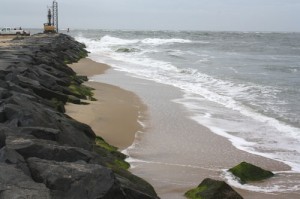
OCEAN CITY — A rarely-seen “anomaly” in the Ocean City Inlet reappeared this week in the form of a wide, sandy beach on the south side of the north jetty in an area typically under water and pounded by waves.
In the wake of Hurricane Sandy, which plowed through the resort in late October and other coastal storms, nearly all of the beaches in the area were altered to varying degrees with sand eroded from some areas and deposited in others. Perhaps the most startling change in the days after Sandy passed through the area was a sandy spit of new beach as wide as 25 feet at different times depending on the tide on the south side of the rocky north jetty, which, along with the south jetty on the opposite side, provide the manmade bookends for the Inlet created eight decades ago.
City officials and long-time locals said after the storm they had never seen a sandy beach form on the south side of the jetty and surveys were performed to determine the extent of the silting in of the Inlet. The sandy beach on the south side of the Inlet eventually disappeared again, likely corrected by natural processes, but it reappeared again this week. On Tuesday, the beach formed on the Inlet side of the jetty wide enough to set up an umbrella and chair or to walk a dog on. At least one surfer even rode a wave in the Inlet that was breaking on the beach on Tuesday.
Army Corps of Engineers District Engineer Bob Blama said in November he had never seen a beach form in the Inlet before and said it would likely never happen again. When shown the pictures of the new beach in the Inlet again this week, Blama was somewhat surprised it had returned. After the storm, the Corps surveyed all of the navigation channels from the Inlet to the Isle of Wight to the Sinepuxent Bay to determine which need repairs in the aftermath of the storm.
Throughout recent weeks, the “Currituck,” a huge vessel designed specifically for dredging and redistributing sand in the Ocean City area, has been working the waters around the resort correcting issues nature hadn’t taken care of. The Currituck is a dredge hopper that dredges material from silted-in areas along the coast and deposits it in sand-starved areas typically near Assateague. The vessel’s huge hull splits open to fill with sand, closes again, then travels to a sand-starved destination, opens its hull again to deposit the material. The low-draft vessel can typically get close to shore and deposit sand, allowing the natural currents to redistribute it.
Blama said this week he went back to the Inlet at different times after Sandy had passed and the sandy beach next to the rocky jetty had disappeared. With its reappearance this week, Blama said the Corps had no immediate plans to dredge the area adjacent to the jetty because all indications point to the Inlet channel being clear.
“I went back a week later and it was gone,” he said. “All of our surveys show no signs of shoaling in the Inlet channel and this is too close to the wall to get to with the Currituck.”
Blama said the reappearance of the sandy beach on the south side of the Inlet this week was likely caused by the strong winds and heavy surf that prevailed in the area for much of this week and last weekend.
“It appears that the sandy beach on the south side of the Inlet jetty is just an occasional anomaly that will likely correct itself,” he said. “It could be storm-driven. It has been very windy the last couple of days.”
